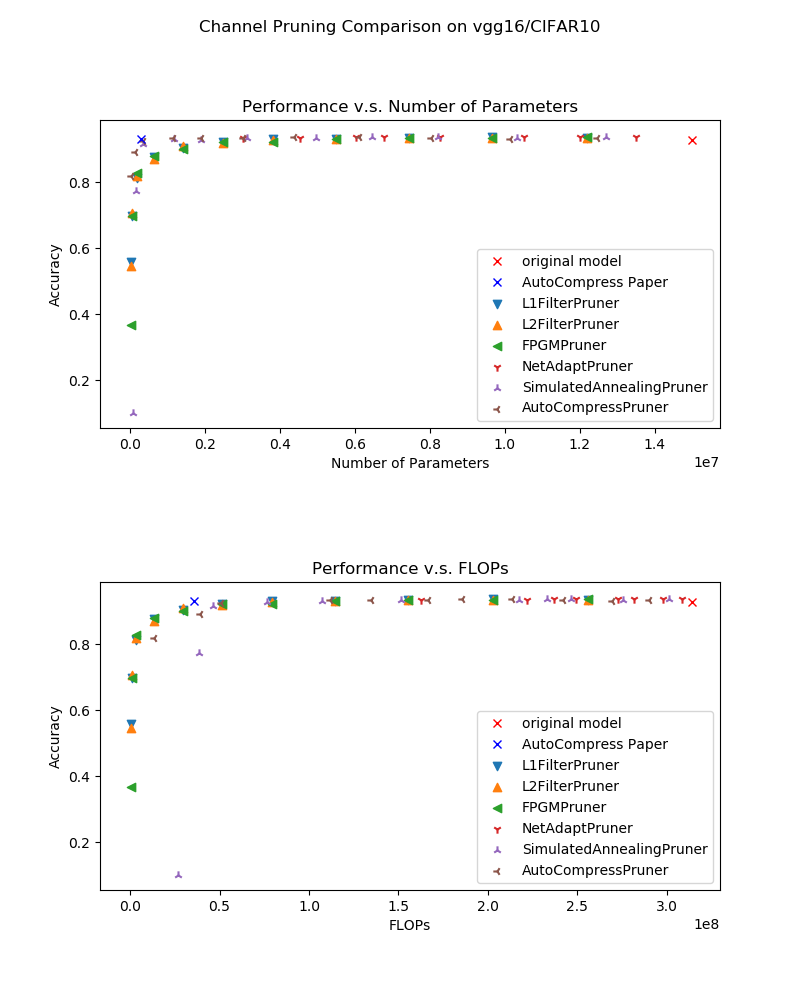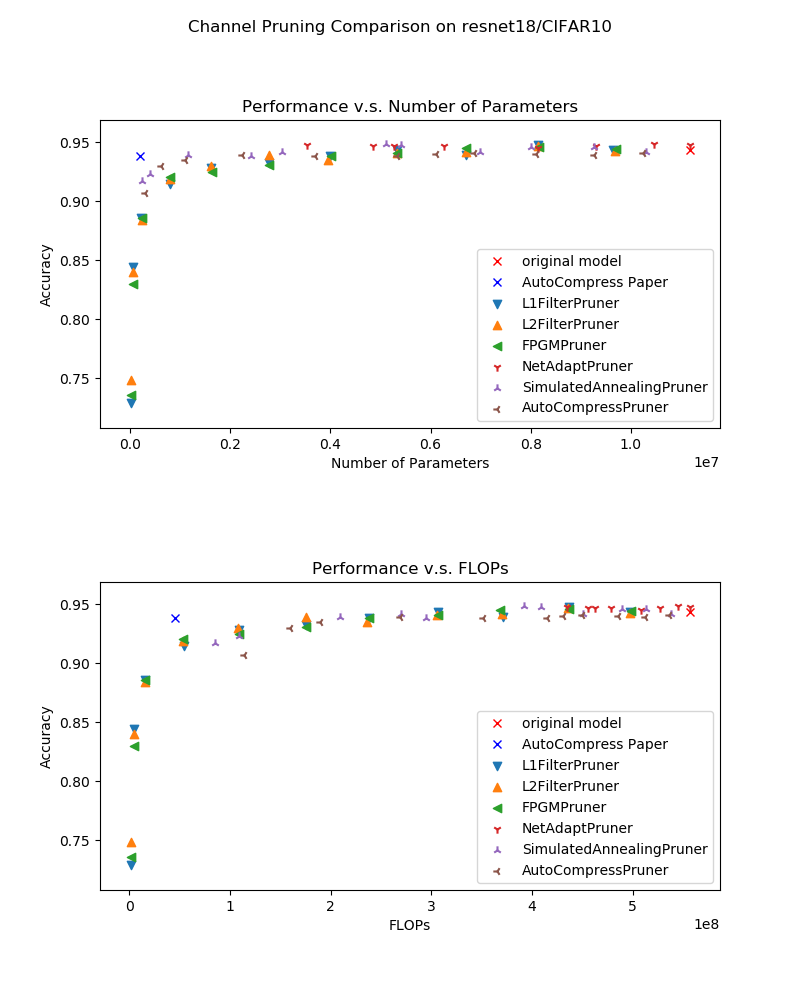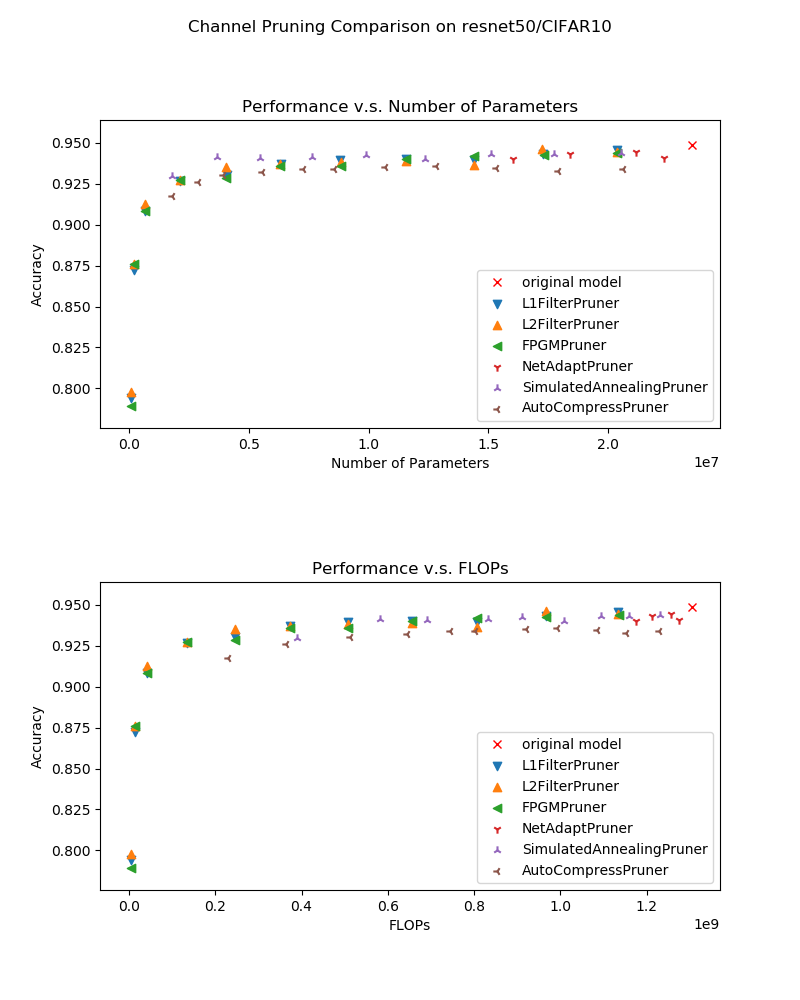Comparison of Filter Pruning Algorithms¶
To provide an initial insight into the performance of various filter pruning algorithms, we conduct extensive experiments with various pruning algorithms on some benchmark models and datasets. We present the experiment result in this document. In addition, we provide friendly instructions on the re-implementation of these experiments to facilitate further contributions to this effort.
Experiment Setting¶
The experiments are performed with the following pruners/datasets/models:
Models: VGG16, ResNet18, ResNet50
Datasets: CIFAR-10
Pruners:
These pruners are included:
Pruners with scheduling :
SimulatedAnnealing Pruner,NetAdapt Pruner,AutoCompress Pruner. Given the overal sparsity requirement, these pruners can automatically generate a sparsity distribution among different layers.One-shot pruners:
L1Filter Pruner,L2Filter Pruner,FPGM Pruner. The sparsity of each layer is set the same as the overall sparsity in this experiment.
Only filter pruning performances are compared here.
For the pruners with scheduling,
L1Filter Pruneris used as the base algorithm. That is to say, after the sparsities distribution is decided by the scheduling algorithm,L1Filter Pruneris used to performn real pruning.All the pruners listed above are implemented in nni.
Experiment Result¶
For each dataset/model/pruner combination, we prune the model to different levels by setting a series of target sparsities for the pruner.
Here we plot both Number of Weights - Performances curve and FLOPs - Performance curve. As a reference, we also plot the result declared in the paper AutoCompress: An Automatic DNN Structured Pruning Framework for Ultra-High Compression Rates for models VGG16 and ResNet18 on CIFAR-10.
The experiment result are shown in the following figures:
CIFAR-10, VGG16:

CIFAR-10, ResNet18:

CIFAR-10, ResNet50:

Analysis¶
From the experiment result, we get the following conclusions:
Given the constraint on the number of parameters, the pruners with scheduling (
AutoCompress Pruner,SimualatedAnnealing Pruner) performs better than the others when the constraint is strict. However, they have no such advantage in FLOPs/Performances comparison since only number of parameters constraint is considered in the optimization process;The basic algorithms
L1Filter Pruner,L2Filter Pruner,FPGM Prunerperforms very similarly in these experiments;NetAdapt Prunercan not achieve very high compression rate. This is caused by its mechanism that it prunes only one layer each pruning iteration. This leads to un-acceptable complexity if the sparsity per iteration is much lower than the overall sparisity constraint.
Experiments Reproduction¶
Implementation Details¶
The experiment results are all collected with the default configuration of the pruners in nni, which means that when we call a pruner class in nni, we don’t change any default class arguments.
Both FLOPs and the number of parameters are counted with Model FLOPs/Parameters Counter after model speed up. This avoids potential issues of counting them of masked models.
The experiment code can be found here.
Experiment Result Rendering¶
If you follow the practice in the example, for every single pruning experiment, the experiment result will be saved in JSON format as follows:
{ "performance": {"original": 0.9298, "pruned": 0.1, "speedup": 0.1, "finetuned": 0.7746}, "params": {"original": 14987722.0, "speedup": 167089.0}, "flops": {"original": 314018314.0, "speedup": 38589922.0} }
The experiment results are saved here. You can refer to analyze to plot new performance comparison figures.
Contribution¶
TODO Items¶
Pruners constrained by FLOPS/latency
More pruning algorithms/datasets/models
Issues¶
For algorithm implementation & experiment issues, please create an issue.